IN THE TRENCHES
Draining water away from a boggy area can make your land more usable. This article shows you how some sub-surface drainage was installed using a backhoe and a few simple materials.
Principles
|
|
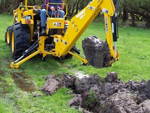
| 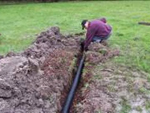
| 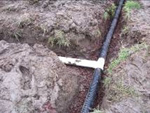
| 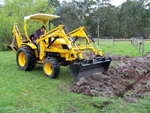
|
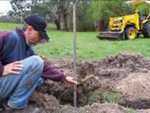
| 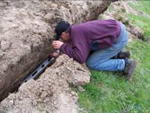
| 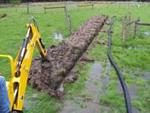
| 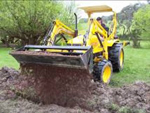
|
| The first drain is used to draw water away from the surface and collect it underground. A trench is dug through the wet area. The trench is filled with crushed rock and pipe with holes in it – commonly known as ag pipe. This sub surface drain enables water to soak through the soil, crushed rock and into the ag pipe. Cloth known as geofabric can be used to minimise silt blocking up the crushed rock or ag pipe.
Closed Pipe Drain The ag drain is then connected to a pipe without holes (PVC storm water pipe) and directed to a lower point. Ideally this point will be above ground where the water can continue to flow away naturally. |
It is not always practical to discharge the water above ground. In these instances it will be necessary to direct the water to a soakage trench or pit where the water can dissipate underground. This works on the reverse action of the ag drain above where water is directed into the ground using ag pipe and crushed rock.
Planning
Firstly it is a good idea to contact your local authority regarding applicable drainage regulations. There may be limitations on where you can direct the water. For example it just wouldn’t be right to transfer your bog over the fence into the neighbours place!
A number of dimensions on trench depths, spacings, pipe diameters etc. are referred to for this specific project. Variables such as your soil permeability rates and water volumes will need to be considered. Various drainage layouts such as herringbone pattern can also used. Consult a local with experience in your conditions.
Measure up the boggy area and decide where you will direct the water to. This will enable you to work out the materials required.
How much Ag Pipe?
How much PVC Pipe?
The length of PVC pipe required is simply how far you need to pipe the water from the ag drain to where you plan to disperse it. 90mm stormwater pipe was used here.
How much Crushed Rock? |
|
| Trenches are generally dug about 600mm deep and require approximately 500mm of crushed rock and then 100mm of soil on top. 50mm of crushed rock goes in the bottom of the trench, then the pipe, then another 450mm of crushed rock on top of the pipe. To calculate how much you need simply multiply the length by width of trench by the desired depth of material. The width of the trench will be about 25mm wider than the width of your bucket. Note: it is important that all dimension used are in metres.
There are a variety of crushed rock types and sizes available. Talk to your garden supplies. 12mm scoria was used for this project. |
Before You Dig
Warning – check that there are no services such as electricity, gas, phone or water underground in the area where you plan to dig. If in doubt there is a service called “dial before you dig” to identify underground lines. Dial 1100 or visit www.dialbeforeyoudig.com.au.
Use a stringline and pressure pack marker to mark the trenches to be dug.
Digging
Dig along the marked out line using the back hoe to form a trench. The drain will be much more effective if you dig till you hit clay. Use a stick with the depth marked on it to make a rough check trench depth from time to time.
The trench requires a slight fall to allow water to flow away.This can be checked with a spirit level placed on a long straight piece of timber. Fall should be approximately 1 in 100. This means for every metre (100cm) the trench goes across it needs to become 1 cm deeper.
Plumbing & Filling the Trench
50mm of scoria is placed in the bottom of the trench. Remember scoria is only required in the trench with ag pipe and not the trench with PVC pipe in it. A 4-in-1 front end loader bucket that opens and closes in the middle makes it easy to place a little in at a time. Even still it will be necessary to spread it around with a rake or similar.
Next lay the ag pipe on top of the scoria. The ag pipe is then teed into PVC storm water pipe. The open ends of the ag pipe are capped off to prevent them filling with silt.
Scoria is then placed on top of the ag pipe using the front end loader bucket. Geofabric may be placed on top of the scoria to reduce silt blocking the drain.
Finally fill the trench by pushing some of the soil back in using the front end loader. If you dug up clay avoid putting this back in the trench as it will prevent water from soaking into the drain. A deeper layer of soil on top of the crushed rock is better for pasture growth. Conversely, a shallower layer of soil will provide better drainage.
Slightly overfill the soil to allow for settling. Even still you will have some left over. It may be possible to use excess soil to fill some other low spots on the property.
Safety is always the highest priority. Always use a tractor that complies with Australian Standards, including Roll Over Protective Structure, seat belt and protective covers. Only take on tasks within the capability of the machine and operator. Follow all relevant safety warnings, instructions and regulations. Wear appropriate safety equipment and use common sense.
* This article is a general guide only. Conditions vary from site to site. Judgement relating to your individual conditions must be exercised.






View More(Total0)Comment Lists